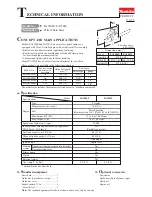
26
7
13. EXPLANATION OF SYMBOLS
5. HEALTH & SAFETY INFORMATION
13.1 EXPLANATION OF SYMBOLS
Warning!
Wear dust mask.
Warning!
Wear goggles.
Warning!
Wear ear defenders.
Warning!
Read the instruction
Manual
Keep hands away from saw
blades.
Single value noise marking.
(maximum declared
A-Weighted sound power
level in decibels).
WEEE
Do not dispose of Waste
Electrical & Electronic
Equipment in with domestic
rubbish.
L
WA
dB
Wait for the machine to stop.
Unless the machine is fitted with a safety brake; some parts may
continue to move due to momentum. Wait for all parts to stop; then unplug it from the power
supply before making any adjustments, carrying out maintenance operations or just finishing
using the tool.
Remove and check setting tools.
Some machinery requires the use of additional tools or keys to
set, load or adjust the power tool. Before starting the power tool always check to make certain
they have been removed and are safely away from the machine.
Prevent unintentional starting.
Before plugging any machine in to the power supply, make sure
the switch is in the OFF position. If the machine is portable; do not hold the machine near the
switch and take care when putting the machine down; that nothing can operate the switch.
Carefully select an extension lead.
Some machines are not suitable for use with extension leads. If
the tool is designed for use outdoors; use an extension lead also suitable for that environment.
When using an extended lead, select one capable of handling the current (amps) drawn by the
machine in use. Fully extend the lead regardless of the distance between the power supply and the
tool. Excess current (amps) and a coiled extension lead will both cause the cable to heat up and
can result in fire.
Concentrate and stay alert.
Distractions are likely to cause an accident. Never operate a power tool
if you are under the influence of drugs (prescription or otherwise), including alcohol or if you are
feeling tired. Being disorientated will result in an accident.
Have this tool repaired by a qualified person.
This tool is designed to confirm to the relevant
international and local standards and as such should be maintained and repaired by someone
qualified; using only original parts supplied by the manufacturer: This will ensure the tool remains
safe to use.
5.2 SPECIFIC SAFETY INSTRUCTIONS FOR TABLE SAWS
WARNING
For your own safety, do not operate your saw until it is completely assembled and installed
according to the instructions....and until you have read and understood the safety rules,
assembly procedures, adjustment procedures and maintenance etc.
1. STABILITY.
There may be a tendency for the saw to tip over or move during certain cutting operations,
such as, cutting extremely large heavy panels or long heavy boards, so the saw must be
bolted down.
2. MINIMISE POTENTIAL ACCIDENTS.
Most accidents are caused by
FAILURE TO FOLLOW SET UP AND OPERATION
INSTRUCTIONS.
Avoid awkward hand positions, where a sudden slip could cause a hand to move into a saw
blade or other cutting tool. Never reach behind, or around the blade with the hand holding
down the workpiece for any reason.
DO NOT PLACE FINGERS OR HANDS IN THE PATH OF THE SAW BLADE.
3.
Never reach under your machine when operating or make any adjustments when it is
running.
4.
Turn the saw 'OFF' and disconnect the power supply when changing the blade, removing or
replacing the blade guard, or making any adjustments.
5.
Always maintain control of the workpiece.
DO NOT ‘LET GO’
of the workpiece until the machine
has stopped.
6.
When removing short workpieces, or cleaning up around the table, be sure the saw is switched
'OFF'.
7.
Never turn the saw
'ON'
before clearing the table of all tools, wood scraps, etc., except the
workpiece and related feed or support devices for the operation.
8.
When moving the saw, disconnect power supply.








































